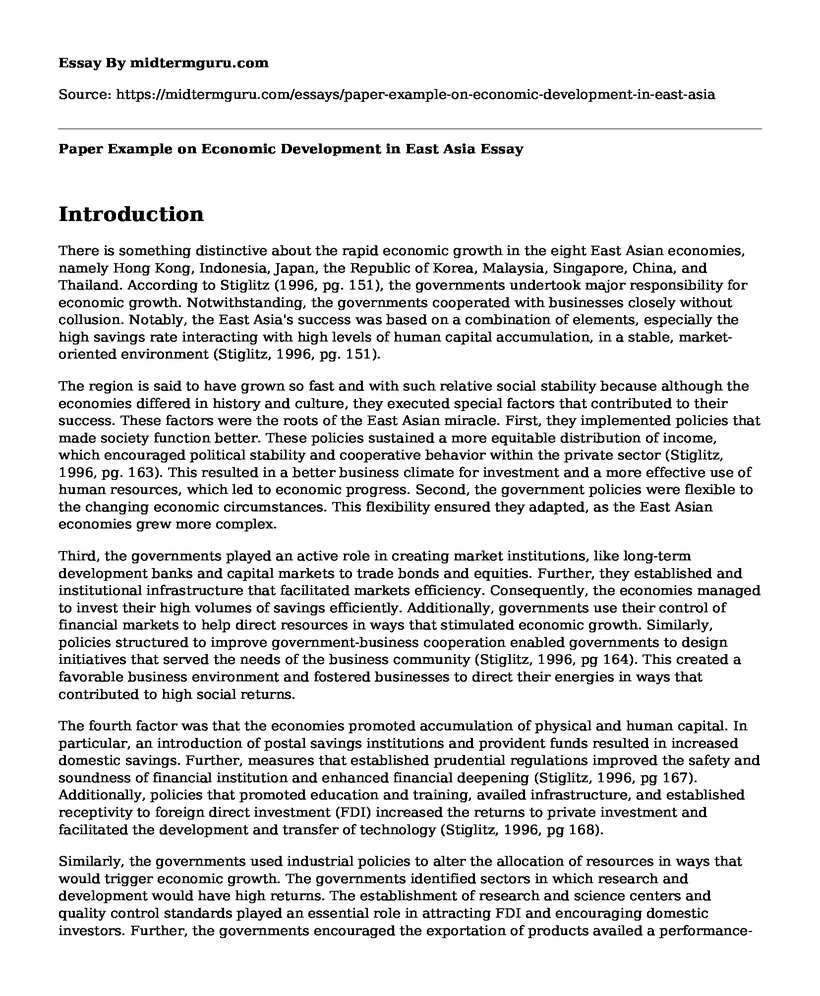Introduction
There is something distinctive about the rapid economic growth in the eight East Asian economies, namely Hong Kong, Indonesia, Japan, the Republic of Korea, Malaysia, Singapore, China, and Thailand. According to Stiglitz (1996, pg. 151), the governments undertook major responsibility for economic growth. Notwithstanding, the governments cooperated with businesses closely without collusion. Notably, the East Asia's success was based on a combination of elements, especially the high savings rate interacting with high levels of human capital accumulation, in a stable, market-oriented environment (Stiglitz, 1996, pg. 151).
The region is said to have grown so fast and with such relative social stability because although the economies differed in history and culture, they executed special factors that contributed to their success. These factors were the roots of the East Asian miracle. First, they implemented policies that made society function better. These policies sustained a more equitable distribution of income, which encouraged political stability and cooperative behavior within the private sector (Stiglitz, 1996, pg. 163). This resulted in a better business climate for investment and a more effective use of human resources, which led to economic progress. Second, the government policies were flexible to the changing economic circumstances. This flexibility ensured they adapted, as the East Asian economies grew more complex.
Third, the governments played an active role in creating market institutions, like long-term development banks and capital markets to trade bonds and equities. Further, they established and institutional infrastructure that facilitated markets efficiency. Consequently, the economies managed to invest their high volumes of savings efficiently. Additionally, governments use their control of financial markets to help direct resources in ways that stimulated economic growth. Similarly, policies structured to improve government-business cooperation enabled governments to design initiatives that served the needs of the business community (Stiglitz, 1996, pg 164). This created a favorable business environment and fostered businesses to direct their energies in ways that contributed to high social returns.
The fourth factor was that the economies promoted accumulation of physical and human capital. In particular, an introduction of postal savings institutions and provident funds resulted in increased domestic savings. Further, measures that established prudential regulations improved the safety and soundness of financial institution and enhanced financial deepening (Stiglitz, 1996, pg 167). Additionally, policies that promoted education and training, availed infrastructure, and established receptivity to foreign direct investment (FDI) increased the returns to private investment and facilitated the development and transfer of technology (Stiglitz, 1996, pg 168).
Similarly, the governments used industrial policies to alter the allocation of resources in ways that would trigger economic growth. The governments identified sectors in which research and development would have high returns. The establishment of research and science centers and quality control standards played an essential role in attracting FDI and encouraging domestic investors. Further, the governments encouraged the exportation of products availed a performance-based criterion for allocating of resources, fostered the adoption of international standards, and fastened the diffusion of technology (Stiglitz, 1996, pg 166)
Finally, the policies supported investment as they enhanced the ability of firms to bear risks. Also, policies and programs that led to more effective risk-sharing within the economy reduced the effective cost of capital, hence stimulating investment. Additionally, government intervention in international economic relations such as bargaining for foreign technology and in insisting on specific transfers of technology as part of foreign investment encouraged the national interest, enhanced economic stability, and increased savings in the East Asian economies (Stiglitz,1996, pg 169 - 171).
Conclusion
However, Japan, unlike the other East Asian economies, somehow had unique economic institutions and policies. For example, Japan was successful in targeting industries for import substitutions (Ito & Weinstein, 1996, pg 256). Thus, it did not depend on exports only. Additionally, in the 1950s, when Japan was investing in its manufacturing industries, it did not have either international capital markets or institutional investors on whom to draw. Instead, it relied only on domestic savings to supply funds for investment. This helped it avoid the deterioration in the balance of international payments and inflation (Ito & Weinstein, 1996, pg 259).
References
Ito, T., & Weinstein, D. E. (1996). Japan and the Asian economies: A" miracle" in transition. Brookings Papers on Economic Activity, 1996(2), 205-272.
Stiglitz, J. E. (1996). Some lessons from the East Asian miracle. The world Bank research observer, 11(2), 151-177.
Cite this page
Paper Example on Economic Development in East Asia. (2022, Sep 28). Retrieved from https://midtermguru.com/essays/paper-example-on-economic-development-in-east-asia
If you are the original author of this essay and no longer wish to have it published on the midtermguru.com website, please click below to request its removal:
- Socio-Economic Effects Induced by Capitalistic to Socialistic Economic System
- Americans' Support of Vietnam War: Cold War Causes and Effects - Essay Sample
- The Equal Employment Opportunity Act: Fighting Discrimination in the US - Essay Sample
- Exploring Inequality & Mistreatment of Domestic Workers in Hong Kong - Essay Sample
- Salary Increase and Training Program: Key to Employee Retention - Essay Sample
- Equal Employment: Overcoming Racism, Homelessness to Achieve Success - Essay Sample
- Quilombola Pottery: Globalization, Economic Anthropology, and Sustainability - Essay Sample







